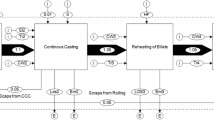Abstract
Life cycle assessment is a powerful tool in the evaluation of the environmental performance. However, there is no generally accepted methodology. To develop a practical method, an accumulative model for the comparative life cycle assessment is established and applied in the two typical iron and steel processes, the DRI/EF process and the BF/BOF process. The results indicate that the method could quantitatively compare the alternatives. When the DRI/EF process is compared with the BF/BOF process, it is shown that the IREI (integrated relative environmental index) is 60.22% for the production of iron and 52.4% for the production of steel, respectively. The environmental performance of the DRI/EF process is superior to that of the BF/BOF process.
Similar content being viewed by others
References
Azapagic A (1999): Life Cycle assessment and its application to process selection, design and optimization. Chemical Engineering Journal 73: 1–21
Aresta M, Galatola M (1999): Life cycle analysis applied to the assessment of the environmental impact of alternative synthetic process. The dimethylcarbonate case: part 1. Journal of Cleaner Production 7: 181–193
Verschoor AH, Reijnders L (1999): The use of life cycle methods by seven major companies. Journal of Cleaner production 7: 375–382
Michaelis P, Jackson T, Gift R (1998): Exergy analysis of the life cycle of steel. Energy 23 (3): 213–220
Graedel TE, Allenby BR, Comrie PR (1995): Matrix approaches to abridged life cycle assessment. Environmental science & Technology 29 (3): 136A-140A
Eaga P, Weinberg L (1999): Application of analytic hierarchy process techniques to streamlined life-cycle analysis of two anodizing processes. Environmental science & Technology 33 (9): 1495–1500
Hendrickson C, Horvath A, Joshi S, Lava L (1998): Economic input-output models for environmental life-cycle assessment. Environmental Science & Technology 32: 184A-191A
Assies JA (1998): A risk-based approach to life cycle impact assessment. Journal of Hazardous Materials 61: 23–29
Ong SK, Koh TH, Nee AYC (1999): Development of semi-Quantitative Pre-LCA tool. Journal of Materials Processing Technology (89-90): 574–582
Choi ACK, Kaebernick H, Lai WH (1997): Manufacturing process modeling for environmental impact assessment. Journal of Materials Processing Technology 70: 574–582
Yoshioka M (1998): Study of a methodology for life cycle assessment using a relative process model. International Journal of Global Energy Issue 11 (1-4): 104–110
Bengtsson M, Steen B (2000): Weighting in LCA-approaches and applications. Environmental Progress 19 (2): 101–109
Itsubo N, Inaba A, Matsuno Y, Tasui I, Yamamoto R (2000): Current status of weighting methodologies in Japan. Int J LCA 5 (1): 5–11
Author information
Authors and Affiliations
Corresponding author
Rights and permissions
About this article
Cite this article
Li, G., Nie, Z., Zhou, H. et al. An accumulative model for the comparative life cycle assessment case study: iron and steel process. Int J LCA 7, 225–229 (2002). https://doi.org/10.1007/BF02978877
Received:
Accepted:
Issue Date:
DOI: https://doi.org/10.1007/BF02978877




